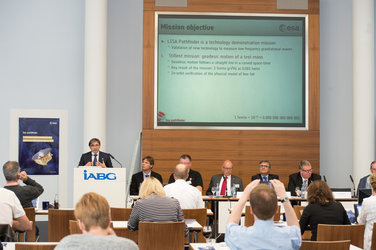Accept all cookies Accept only essential cookies See our Cookie Notice

About ESA
The European Space Agency (ESA) is Europe’s gateway to space. Its mission is to shape the development of Europe’s space capability and ensure that investment in space continues to deliver benefits to the citizens of Europe and the world.
Highlights
ESA - United space in Europe
This is ESA ESA facts Member States & Cooperating States Funding Director General Top management For Member State Delegations European vision European Space Policy ESA & EU Responsibility & Sustainability Annual Report Calendar of meetings Corporate newsEstablishments & sites
ESA Headquarters ESA ESTEC ESA ESOC ESA ESRIN ESA EAC ESA ESAC Europe's Spaceport ESA ESEC ESA ECSAT Brussels Office Washington OfficeWorking with ESA
Business with ESA ESA Commercialisation Gateway Law at ESA Careers Cyber resilience at ESA IT at ESA Newsroom Partnerships Merchandising Licence Education Open Space Innovation Platform Integrity and Reporting Administrative Tribunal Health and SafetyMore about ESA
History ESA Historical Archives Exhibitions Publications Art & Culture ESA Merchandise Kids Diversity ESA Brand Centre ESA ChampionsLatest
Space in Member States
Find out more about space activities in our 23 Member States, and understand how ESA works together with their national agencies, institutions and organisations.
Science & Exploration
Exploring our Solar System and unlocking the secrets of the Universe
Go to topicAstronauts
Missions
Juice Euclid Webb Solar Orbiter BepiColombo Gaia ExoMars Cheops Exoplanet missions More missionsActivities
International Space Station Orion service module Gateway Concordia Caves & Pangaea BenefitsLatest
Space Safety
Protecting life and infrastructure on Earth and in orbit
Go to topicAsteroids
Asteroids and Planetary Defence Asteroid danger explained Flyeye telescope: asteroid detection Hera mission: asteroid deflection Near-Earth Object Coordination CentreSpace junk
About space debris Space debris by the numbers Space Environment Report In space refuelling, refurbishing and removingSafety from space
Clean Space ecodesign Zero Debris Technologies Space for Earth Supporting Sustainable DevelopmentLatest
Applications
Using space to benefit citizens and meet future challenges on Earth
Go to topicObserving the Earth
Observing the Earth Future EO Copernicus Meteorology Space for our climate Satellite missionsCommercialisation
ESA Commercialisation Gateway Open Space Innovation Platform Business Incubation ESA Space SolutionsLatest
Enabling & Support
Making space accessible and developing the technologies for the future
Go to topicBuilding missions
Space Engineering and Technology Test centre Laboratories Concurrent Design Facility Preparing for the future Shaping the Future Discovery and Preparation Advanced Concepts TeamSpace transportation
Space Transportation Ariane Vega Space Rider Future space transportation Boost! Europe's Spaceport Launches from Europe's Spaceport from 2012Latest

Measuring spacetime curvature
Thank you for liking
You have already liked this page, you can only like it once!
This illustration shows a ‘thought experiment’ to measure the curvature of spacetime, based on an idea proposed by theoretical physicist Felix Pirani. Albert Einstein was famous for envisaging such thought experiments, investigating the consequences of a particular physical problem only in one’s mind.
In the illustration, the blue surface represents a curved space, which is not ‘flat’ but is distorted by the presence of massive bodies, like the spacetime described in Einstein's general theory of relativity. In the non-flat world of general relativity, free-falling objects subject to gravity alone move along geodesics – the equivalent of straight lines in curved geometry.
The two white lines represent the geodesics along which two free-falling particles are moving. In this thought experiment, the first particle sends a light ray (orange line) to the second, which receives it and sends it back. Even though light does not have mass, it feels the effect of gravity as it moves through curved spacetime, spending energy to escape the gravitational pull of a massive object and gaining energy upon approaching it.
These energy changes translate to changes in the light frequency, so monitoring variations in the frequency of the light rays that the two particles are sending back and forth is a way to measure the curvature of spacetime between them.
This is the principle underlying the detection of gravitational waves – ripples in the fabric of spacetime produced by accelerating massive bodies. If such a perturbation passes by, it would change the curvature of spacetime between the two particles, leaving an imprint on the frequency of the light they exchange.
-
CREDIT
ESA/ATG medialab -
LICENCE
ESA Standard Licence

Spacetime curvature

Cesar Garcia Marirrodriga gives an overview of LISA…

Cesar Garcia Marirrodriga gives an overview of LISA…

LISA Pathfinder launch composite at IABG’s space test centre















 Germany
Germany
 Austria
Austria
 Belgium
Belgium
 Denmark
Denmark
 Spain
Spain
 Estonia
Estonia
 Finland
Finland
 France
France
 Greece
Greece
 Hungary
Hungary
 Ireland
Ireland
 Italy
Italy
 Luxembourg
Luxembourg
 Norway
Norway
 The Netherlands
The Netherlands
 Poland
Poland
 Portugal
Portugal
 Czechia
Czechia
 Romania
Romania
 United Kingdom
United Kingdom
 Slovenia
Slovenia
 Sweden
Sweden
 Switzerland
Switzerland

























